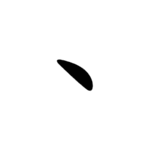Radical 3
Radical 3 meaning "to indicate an end"[1] is one of six of the 214 Kangxi radicals that are composed of only one stroke.
| 丶 | ||
|---|---|---|
| ||
| 丶 (U+4E36) "dot" | ||
| Pinyin: | zhǔ | |
| Bopomofo: | ㄓㄨˋ | |
| Wade–Giles: | chu3 | |
| Cantonese Yale: | jyu2 | |
| Jyutping: | zyu2 | |
| Pe̍h-ōe-jī: | tú | |
| Kana: | チュ chu てん ten | |
| Kanji: | 点 ten | |
| Hangul: | 점 jeom | |
| Sino-Korean: | 주 ju | |
| Stroke order animation | ||
 | ||
In the Kangxi Dictionary, there are only 10 characters (out of 49,030) to be found under this radical.
Characters with Radical 3

Small Seal script character
| Strokes | Characters & Pinyin & Meanings |
|---|---|
| 0 | 丶 zhǔ "dot" |
| 1 | 丷 (Korean kwukyel note) |
| 2 | 丸 wán "pellet" |
| 3 | 丹 dān "vermillion", 为 wéi "to do, to be" |
| 4 | 主 zhǔ "owner, master", 丼 jǐng "bowl" |
| 7 | 丽 lì "pretty, lovely" |
| 8 | 举 jǔ "raise, recommend" |
gollark: My server's load average is way too high.
gollark: I'm quite busy dealing with beeonic incursions on my end.
gollark: We host bees on there right now.
gollark: You could semiunironically use IPFS or something.
gollark: I don't understand why johnvertisements aren't rehosted on all participating computers such that they are present in all spacetime?
References
- Shuowen Jiezi: “丶,有所絶止,丶而識之也”. "Where there is an end, 丶 is used to recognize it." This refers to the practice of using 丶 as a judou punctation mark.
Literature
- Fazzioli, Edoardo (1987). Chinese calligraphy : from pictograph to ideogram : the history of 214 essential Chinese/Japanese characters. calligraphy by Rebecca Hon Ko. New York: Abbeville Press. ISBN 0-89659-774-1.
- Leyi, Li (1993). Tracing the Roots of Chinese Characters: 500 Cases. Beijing. ISBN 978-7-5619-0204-2.
This article is issued from Wikipedia. The text is licensed under Creative Commons - Attribution - Sharealike. Additional terms may apply for the media files.